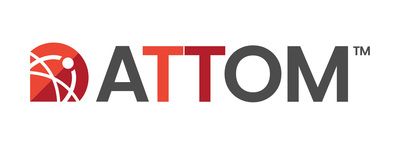HOME VALUES IN OPPORTUNITY ZONES CONTINUE TO RIDE COATTAILS OF NATIONAL GAINS DURING FOURTH QUARTER
Prices in Opportunity Zones Targeted for Economic Redevelopment Again Track Broader Changes in U.S. Housing Market; Median Values Rise Quarterly in Half the Zones and Annually in Almost Two-Thirds; Some Measures in Opportunity Zones Again Show Even Better Improvements Than Elsewhere
IRVINE, Calif., Feb. 13, 2025 /PRNewswire/ -- ATTOM, a leading curator of land, property data, and real estate analytics, today released its fourth-quarter 2024 report analyzing qualified low-income Opportunity Zones targeted by Congress for economic redevelopment in the Tax Cuts and Jobs Act of 2017 (see full methodology below). In this report, ATTOM looked at 3,783 zones around the United States with sufficient data to analyze, meaning they had at least five home sales in the fourth quarter of 2024.
The report found that median single-family home and condo prices increased from the third quarter of 2024 to the fourth quarter of 2024 in 49 percent of Opportunity Zones around the country with enough data to measure. They were up annually in 61 percent of those zones.
As the nation's 13-year housing market boom continued, median prices again grew more than 10 percent annually in almost half the Opportunity Zones analyzed.
Those trends, in and around low-income neighborhoods where the federal government offers tax breaks to spur economic revival, extended a long-term pattern of home values inside Opportunity Zones closely tracking broader nationwide price shifts for at least the last three years. That scenario has held regardless of whether the housing market has seen limited, moderate or robust gains.
Despite overall upswings inside Opportunity Zone markets, the fourth-quarter trends again were mixed, with typical values rising more in higher-priced zones than in the very lowest-priced neighborhoods. That continued to reveal how the very bottom of the U.S. housing market is benefitting less from the national run of price increases, and could be more vulnerable if the broader market surge levels off or reverses.
Nevertheless, the latest patterns mark yet another sign that some of the most distressed communities in the nation are showing economic strength, or limited weakness, compared to other markets around the country.
Moreover, by several important measures, Opportunity Zones enjoyed even more progress than the nation as a whole during the fourth quarter of 2024. For example, median price increases bested typical nationwide gains in a slightly larger portion of Opportunity Zones than elsewhere.
"Micro-markets inside Opportunity Zones continue to reap remarkably consistent benefits from the home-price boom that is still reaching far and wide across the country. Again and again, we are seeing notable levels of economic potential in these areas that have long been in need of revival," said Rob Barber, CEO for ATTOM. "This keeps happening as rising values and tight supplies of homes for sale push many buyers on limited budgets into areas they may not have considered a few years ago."
He added that "Opportunity Zone price trends are far from consistent, with the lowest-end areas struggling to keep up. That's a warning sign for those neighborhoods. But the big takeaway from the latest data is that significant money is flowing into these locations, which can provide a stepping stone for the investment that the Opportunity Zone legislation is intended to spur."
Opportunity Zones are defined in the Tax Act legislation as census tracts in or alongside low-income neighborhoods that meet various criteria for redevelopment in all 50 states, the District of Columbia and U.S. territories. Census tracts, as defined by the U.S. Census Bureau, cover areas that have 1,200 to 8,000 residents, with an average of about 4,000 people.
Amid economic limitations, typical home values across wide swaths of Opportunity Zones remained far below those around most of the nation in the waning months of 2024. Median fourth-quarter prices inside about 80 percent of the zones stood below the U.S. median of $360,000. That was about the same portion as in earlier periods over the past three years. In addition, median prices were still less than $200,000 in almost half the zones.
Considerable price volatility also continued inside Opportunity Zones, with median values either dropping or increasing by at least 5 percent in nearly three-quarters of those locations from the third quarter to the fourth quarter of last year. That again likely reflected small numbers of sales in many zones.
Still, when taken as a whole, the latest overall trends in Opportunity Zones generally matched the nationwide path of prices, which went up 1 percent quarterly and 9 percent annually during the last few months of 2024.
The latest increases came as buyers buoyed by rising wages and a strong investment market chased the ongoing short supply of homes for sale. Those forces helped offset an increase in mortgage rates, which rose back up close to an average of 7 percent for a 30-year fixed loan during the fourth quarter of 2024.
High-level findings from the report:
- Median prices of single-family homes and condos increased from the third quarter of 2024 to the fourth quarter of 2024 in 1,652 (49 percent) of the Opportunity Zones around the U.S. with sufficient data to analyze, while staying the same or decreasing in 51 percent. Measured annually, medians remained up from the fourth quarter of 2023 to same period last year in 1,984 (61 percent) of those zones. (Among the 3,783 Opportunity Zones included in the report, 3,375 had enough data to generate usable median-price comparisons from the third to the fourth quarter of 2024; 3,256 had enough data to make comparisons between the fourth quarter of 2023 and the fourth quarter of 2024).
- In an ongoing potential sign of trouble, median prices were up annually in only 47 percent of Opportunity Zones where homes commonly sold for less than $125,000 during the fourth quarter of 2024. Prices climbed during that time frame in 60 percent to 70 percent of zones with higher home values.
- Among states that had at least 25 Opportunity Zones with enough data to analyze during the fourth quarter of 2024, the largest portions of zones where median prices increased annually were in Indiana (medians up from the fourth quarter of 2023 to the fourth quarter of 2024 in 75 percent of zones), Missouri (74 percent), Wisconsin (73 percent), Kentucky (72 percent) and New Jersey (71 percent). States where prices were up annually in the smallest portion of zones included Louisiana (median prices up in 44 percent of zones), Alabama (44 percent), Arizona (46 percent), Florida (50 percent) and Texas (50 percent).
- States where median home values in Opportunity Zones were up most often quarterly included Kentucky (medians up from the third quarter of 2024 to the fourth quarter of 2024 in 71 percent of zones), Colorado (62 percent), Wisconsin (57 percent), Utah (56 percent) and Arizona (55 percent).
- Of the 3,783 zones in the report, 1,152 (30 percent) had median prices below $150,000 in the fourth quarter of 2024. That was down from 35 percent of zones with sufficient data a year earlier and almost 60 percent five years ago. Another 580 zones (15 percent) had medians in the fourth quarter of last year ranging from $150,000 to $199,999.
- Median values in the fourth quarter of 2024 ranged from $200,000 to $299,999 in 25 percent of Opportunity Zones while they topped the nationwide fourth-quarter median of $360,000 in just 20 percent.
- The Midwest continued in the fourth quarter of 2024 to have larger portions of the lowest-priced Opportunity Zone tracts. Median home values were less than $175,000 in 59 percent of zones in the Midwest, followed by the South (42 percent), the Northeast (41 percent) and the West (5 percent).
- Median household incomes in 86 percent of the Opportunity Zones analyzed were less than the medians in the counties where they were located. Median incomes were less than three-quarters of county-level figures in 52 percent of those zones and less than half in 13 percent.
Report methodology
The ATTOM Opportunity Zones analysis is based on home sales price data derived from recorded sales deeds. Statistics for previous quarters are revised when each new report is issued as more deed data becomes available. ATTOM's analysis compared median home prices in census tracts designated as Opportunity Zones by the Internal Revenue Service. Except where noted, tracts were used for the analysis if they had at least five sales in the fourth quarter of 2024. Median household income data for tracts and counties comes from surveys taken by the U.S. Census Bureau (www.census.gov) from 2019 through 2023. The list of designated Qualified Opportunity Zones is located at U.S. Department of the Treasury. Regions are based on designations by the Census Bureau. Hawaii and Alaska, which the bureau designates as part of the Pacific region, were included in the West region for this report.
About ATTOM
ATTOM provides premium property data and analytics that power a myriad of solutions that improve transparency, innovation, digitization and efficiency in a data-driven economy. ATTOM multi-sources property tax, deed, mortgage, foreclosure, environmental risk, natural hazard, and neighborhood data for more than 155 million U.S. residential and commercial properties covering 99 percent of the nation's population. A rigorous data management process involving more than 20 steps validates, standardizes, and enhances the real estate data collected by ATTOM, assigning each property record with a persistent, unique ID — the ATTOM ID. The 30TB ATTOM Data Warehouse fuels innovation in many industries including mortgage, real estate, insurance, marketing, government and more through flexible data delivery solutions that include ATTOM Cloud, bulk file licenses, property data APIs, real estate market trends, property navigator and more. Also, introducing our newest innovative solution, making property data more readily accessible and optimized for AI applications – AI-Ready Solutions.
Media Contact:
Megan Hunt
Megan.hunt@attomdata.com
Data and Report Licensing:
949.502.8313
datareports@attomdata.com
![]() View original content to download multimedia:https://www.prnewswire.com/news-releases/home-values-in-opportunity-zones-continue-to-ride-coattails-of-national-gains-during-fourth-quarter-302375526.html
View original content to download multimedia:https://www.prnewswire.com/news-releases/home-values-in-opportunity-zones-continue-to-ride-coattails-of-national-gains-during-fourth-quarter-302375526.html
SOURCE ATTOM


